
Question Number 54357 by ajfour last updated on 02/Feb/19
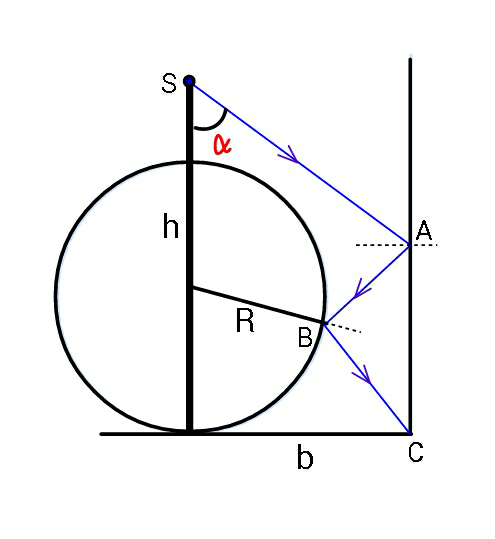
Commented by ajfour last updated on 02/Feb/19
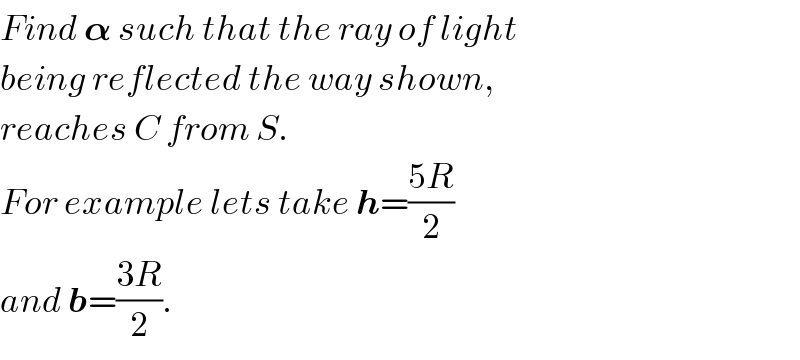
$${Find}\:\boldsymbol{\alpha}\:{such}\:{that}\:{the}\:{ray}\:{of}\:{light} \\ $$$${being}\:{reflected}\:{the}\:{way}\:{shown}, \\ $$$${reaches}\:{C}\:{from}\:{S}. \\ $$$${For}\:{example}\:{lets}\:{take}\:\boldsymbol{{h}}=\frac{\mathrm{5}{R}}{\mathrm{2}} \\ $$$${and}\:\boldsymbol{{b}}=\frac{\mathrm{3}{R}}{\mathrm{2}}. \\ $$
Answered by mr W last updated on 02/Feb/19
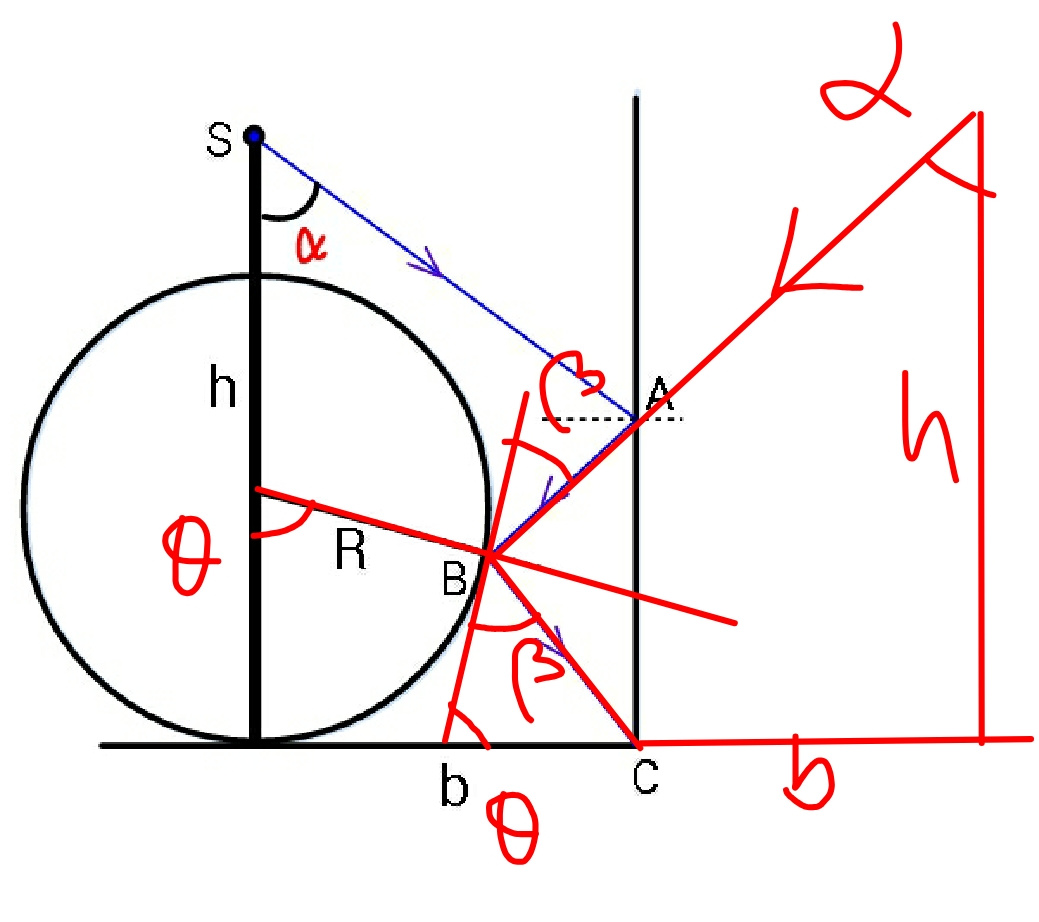
Commented by mr W last updated on 03/Feb/19
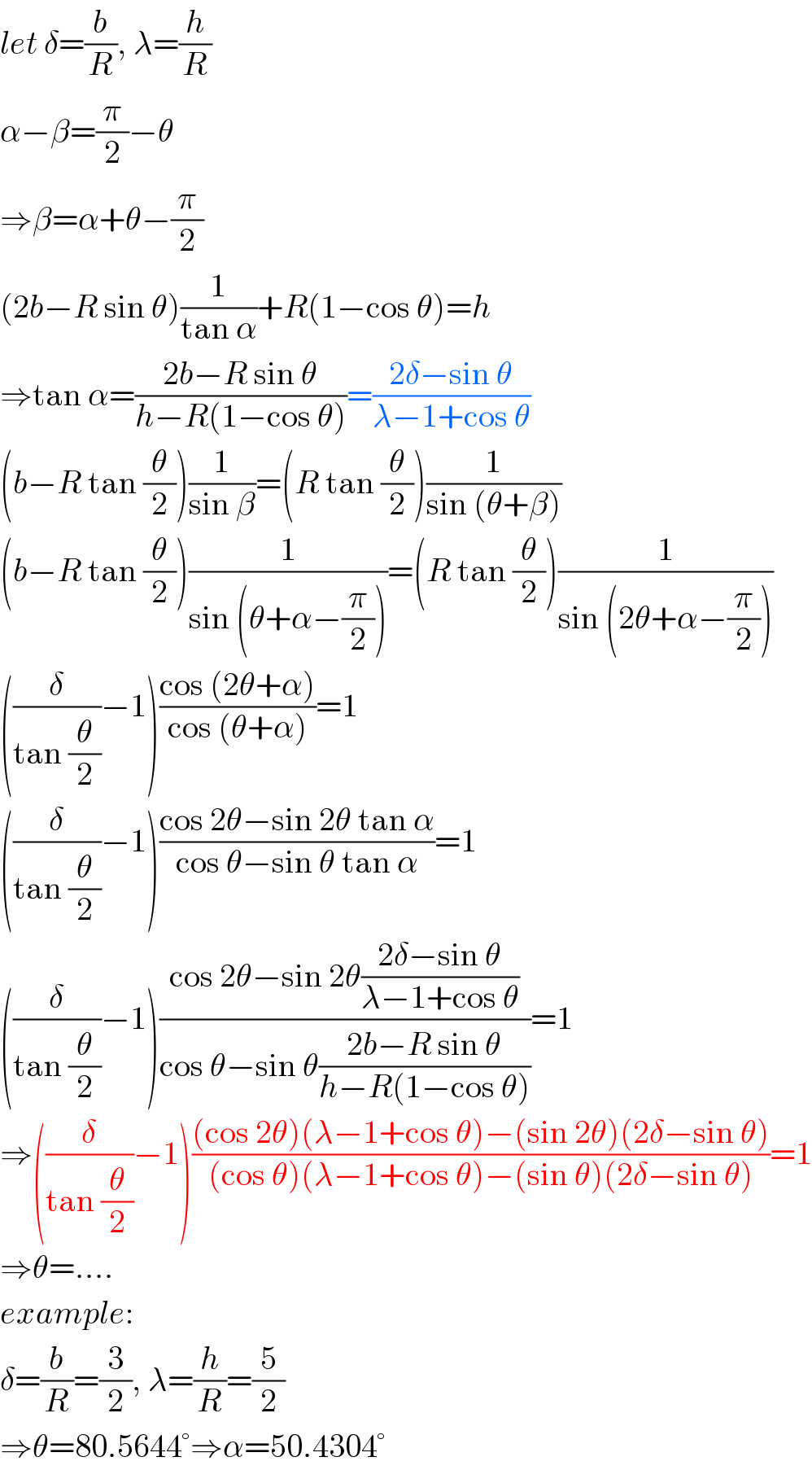
$${let}\:\delta=\frac{{b}}{{R}},\:\lambda=\frac{{h}}{{R}} \\ $$$$\alpha−\beta=\frac{\pi}{\mathrm{2}}−\theta \\ $$$$\Rightarrow\beta=\alpha+\theta−\frac{\pi}{\mathrm{2}} \\ $$$$\left(\mathrm{2}{b}−{R}\:\mathrm{sin}\:\theta\right)\frac{\mathrm{1}}{\mathrm{tan}\:\alpha}+{R}\left(\mathrm{1}−\mathrm{cos}\:\theta\right)={h} \\ $$$$\Rightarrow\mathrm{tan}\:\alpha=\frac{\mathrm{2}{b}−{R}\:\mathrm{sin}\:\theta}{{h}−{R}\left(\mathrm{1}−\mathrm{cos}\:\theta\right)}=\frac{\mathrm{2}\delta−\mathrm{sin}\:\theta}{\lambda−\mathrm{1}+\mathrm{cos}\:\theta} \\ $$$$\left({b}−{R}\:\mathrm{tan}\:\frac{\theta}{\mathrm{2}}\right)\frac{\mathrm{1}}{\mathrm{sin}\:\beta}=\left({R}\:\mathrm{tan}\:\frac{\theta}{\mathrm{2}}\right)\frac{\mathrm{1}}{\mathrm{sin}\:\left(\theta+\beta\right)} \\ $$$$\left({b}−{R}\:\mathrm{tan}\:\frac{\theta}{\mathrm{2}}\right)\frac{\mathrm{1}}{\mathrm{sin}\:\left(\theta+\alpha−\frac{\pi}{\mathrm{2}}\right)}=\left({R}\:\mathrm{tan}\:\frac{\theta}{\mathrm{2}}\right)\frac{\mathrm{1}}{\mathrm{sin}\:\left(\mathrm{2}\theta+\alpha−\frac{\pi}{\mathrm{2}}\right)} \\ $$$$\left(\frac{\delta}{\mathrm{tan}\:\frac{\theta}{\mathrm{2}}}−\mathrm{1}\right)\frac{\mathrm{cos}\:\left(\mathrm{2}\theta+\alpha\right)}{\mathrm{cos}\:\left(\theta+\alpha\right)}=\mathrm{1} \\ $$$$\left(\frac{\delta}{\mathrm{tan}\:\frac{\theta}{\mathrm{2}}}−\mathrm{1}\right)\frac{\mathrm{cos}\:\mathrm{2}\theta−\mathrm{sin}\:\mathrm{2}\theta\:\mathrm{tan}\:\alpha}{\mathrm{cos}\:\theta−\mathrm{sin}\:\theta\:\mathrm{tan}\:\alpha}=\mathrm{1} \\ $$$$\left(\frac{\delta}{\mathrm{tan}\:\frac{\theta}{\mathrm{2}}}−\mathrm{1}\right)\frac{\mathrm{cos}\:\mathrm{2}\theta−\mathrm{sin}\:\mathrm{2}\theta\frac{\mathrm{2}\delta−\mathrm{sin}\:\theta}{\lambda−\mathrm{1}+\mathrm{cos}\:\theta}}{\mathrm{cos}\:\theta−\mathrm{sin}\:\theta\frac{\mathrm{2}{b}−{R}\:\mathrm{sin}\:\theta}{{h}−{R}\left(\mathrm{1}−\mathrm{cos}\:\theta\right)}}=\mathrm{1} \\ $$$$\Rightarrow\left(\frac{\delta}{\mathrm{tan}\:\frac{\theta}{\mathrm{2}}}−\mathrm{1}\right)\frac{\left(\mathrm{cos}\:\mathrm{2}\theta\right)\left(\lambda−\mathrm{1}+\mathrm{cos}\:\theta\right)−\left(\mathrm{sin}\:\mathrm{2}\theta\right)\left(\mathrm{2}\delta−\mathrm{sin}\:\theta\right)}{\left(\mathrm{cos}\:\theta\right)\left(\lambda−\mathrm{1}+\mathrm{cos}\:\theta\right)−\left(\mathrm{sin}\:\theta\right)\left(\mathrm{2}\delta−\mathrm{sin}\:\theta\right)}=\mathrm{1} \\ $$$$\Rightarrow\theta=.... \\ $$$${example}: \\ $$$$\delta=\frac{{b}}{{R}}=\frac{\mathrm{3}}{\mathrm{2}},\:\lambda=\frac{{h}}{{R}}=\frac{\mathrm{5}}{\mathrm{2}} \\ $$$$\Rightarrow\theta=\mathrm{80}.\mathrm{5644}°\Rightarrow\alpha=\mathrm{50}.\mathrm{4304}° \\ $$
Commented by ajfour last updated on 03/Feb/19

$${far}\:{too}\:{good}\:{Sir},\:{thanks}. \\ $$$${what}\:{if}\:{i}\:{assume}\:{tangent}\:{to}\:{circle} \\ $$$${at}\:{point}\:{of}\:{reflection}\:\left({with}\:\theta\:{assumed}\right) \\ $$$${and}\:{take}\:{reflection}\:{of}\:{C}\:{in}\:{tangent}; \\ $$$${and}\:{then}\:{join}\:{S}\:'\:{to}\:{C}\:'.\:{i}\:{think}\:{it}'{ll} \\ $$$${be}\:{unnecessary}\:{and}\:{equivalent}\:{to} \\ $$$${how}\:{you}\:{have}\:{solved}. \\ $$$${Dont}\:{you}\:{think}\:{so}? \\ $$
Commented by mr W last updated on 03/Feb/19

$${that}'{s}\:{correct}\:{sir}.\:\: \\ $$$${i}\:{considered}\:{it}\:{too},\:\:{but}\:{this}\:{doesn}'{t} \\ $$$${help}\:{so}\:{much}\:{if}\:{we}\:{try}\:{to}\:{solve}\:{with} \\ $$$${trigonometrical}\:{method}.\:\:{but}\:{it}\:{helps} \\ $$$${more}\:{if}\:{we}\:{try}\:{to}\:{use}\:{coordinate} \\ $$$${method}. \\ $$
Answered by ajfour last updated on 03/Feb/19
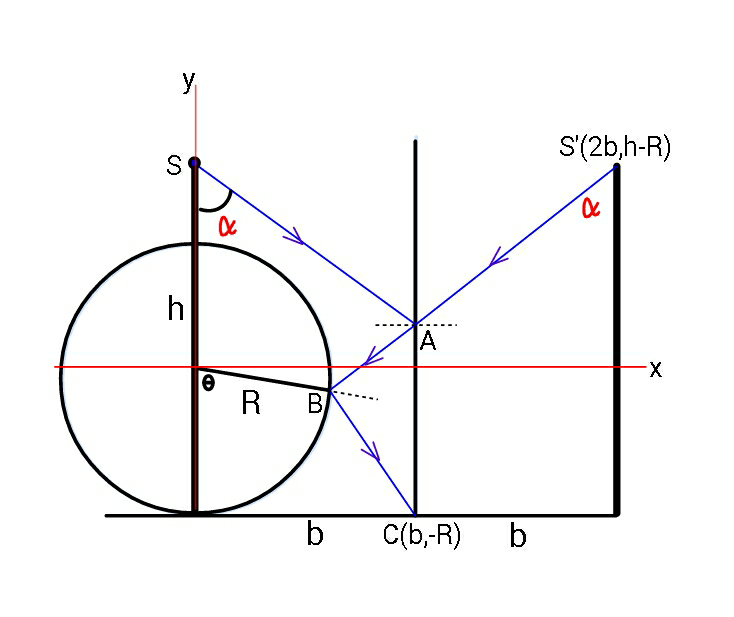
Commented by ajfour last updated on 03/Feb/19
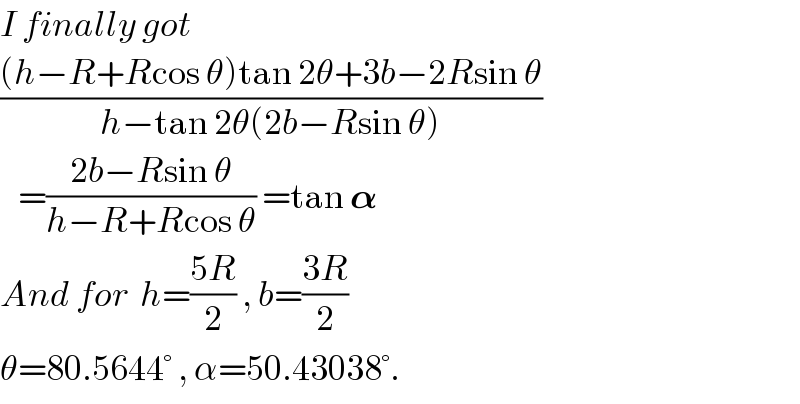
$${I}\:{finally}\:{got} \\ $$$$\frac{\left({h}−{R}+{R}\mathrm{cos}\:\theta\right)\mathrm{tan}\:\mathrm{2}\theta+\mathrm{3}{b}−\mathrm{2}{R}\mathrm{sin}\:\theta}{{h}−\mathrm{tan}\:\mathrm{2}\theta\left(\mathrm{2}{b}−{R}\mathrm{sin}\:\theta\right)} \\ $$$$\:\:\:=\frac{\mathrm{2}{b}−{R}\mathrm{sin}\:\theta}{{h}−{R}+{R}\mathrm{cos}\:\theta}\:=\mathrm{tan}\:\boldsymbol{\alpha} \\ $$$${And}\:{for}\:\:{h}=\frac{\mathrm{5}{R}}{\mathrm{2}}\:,\:{b}=\frac{\mathrm{3}{R}}{\mathrm{2}} \\ $$$$\theta=\mathrm{80}.\mathrm{5644}°\:,\:\alpha=\mathrm{50}.\mathrm{43038}°. \\ $$
Commented by mr W last updated on 03/Feb/19

$${only}\:\mathrm{80}.\mathrm{5644}°\:{is}\:{the}\:{solution}.\:{light}\:{ray} \\ $$$${can}\:{not}\:{go}\:{through}\:{the}\:{circle}.\:\mathrm{90}°\:{is} \\ $$$${the}\:{solution}\:{when}\:\frac{{h}}{{R}}=\mathrm{5}\:{and}\:\frac{{b}}{{R}}=\mathrm{1}.\mathrm{5}. \\ $$
Commented by ajfour last updated on 03/Feb/19

$${yes}\:{Sir},\:{you}\:{are}\:{right}. \\ $$
Commented by mr W last updated on 03/Feb/19
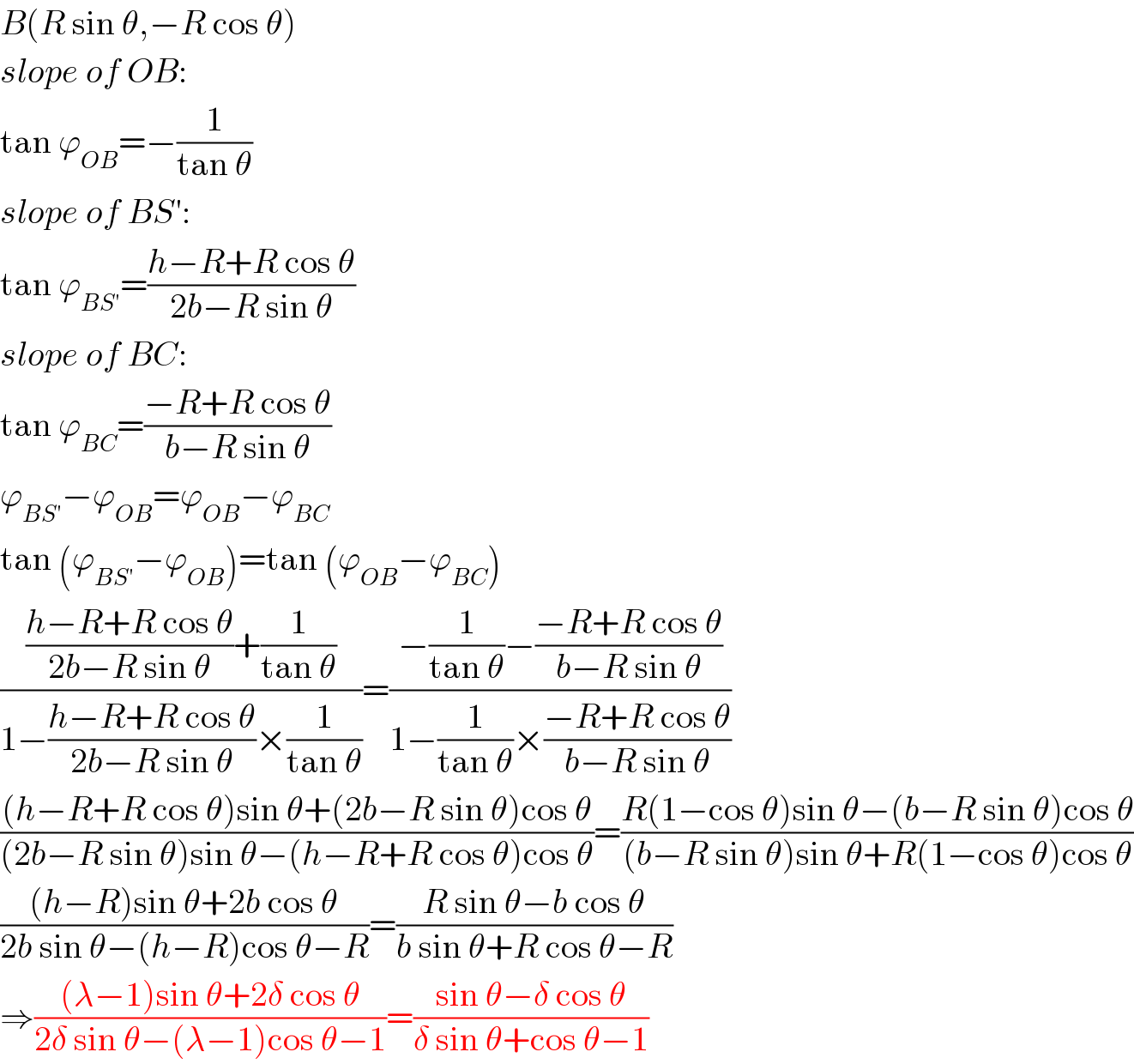
$${B}\left({R}\:\mathrm{sin}\:\theta,−{R}\:\mathrm{cos}\:\theta\right) \\ $$$${slope}\:{of}\:{OB}: \\ $$$$\mathrm{tan}\:\varphi_{{OB}} =−\frac{\mathrm{1}}{\mathrm{tan}\:\theta} \\ $$$${slope}\:{of}\:{BS}': \\ $$$$\mathrm{tan}\:\varphi_{{BS}'} =\frac{{h}−{R}+{R}\:\mathrm{cos}\:\theta}{\mathrm{2}{b}−{R}\:\mathrm{sin}\:\theta} \\ $$$${slope}\:{of}\:{BC}: \\ $$$$\mathrm{tan}\:\varphi_{{BC}} =\frac{−{R}+{R}\:\mathrm{cos}\:\theta}{{b}−{R}\:\mathrm{sin}\:\theta} \\ $$$$\varphi_{{BS}'} −\varphi_{{OB}} =\varphi_{{OB}} −\varphi_{{BC}} \\ $$$$\mathrm{tan}\:\left(\varphi_{{BS}'} −\varphi_{{OB}} \right)=\mathrm{tan}\:\left(\varphi_{{OB}} −\varphi_{{BC}} \right) \\ $$$$\frac{\frac{{h}−{R}+{R}\:\mathrm{cos}\:\theta}{\mathrm{2}{b}−{R}\:\mathrm{sin}\:\theta}+\frac{\mathrm{1}}{\mathrm{tan}\:\theta}}{\mathrm{1}−\frac{{h}−{R}+{R}\:\mathrm{cos}\:\theta}{\mathrm{2}{b}−{R}\:\mathrm{sin}\:\theta}×\frac{\mathrm{1}}{\mathrm{tan}\:\theta}}=\frac{−\frac{\mathrm{1}}{\mathrm{tan}\:\theta}−\frac{−{R}+{R}\:\mathrm{cos}\:\theta}{{b}−{R}\:\mathrm{sin}\:\theta}}{\mathrm{1}−\frac{\mathrm{1}}{\mathrm{tan}\:\theta}×\frac{−{R}+{R}\:\mathrm{cos}\:\theta}{{b}−{R}\:\mathrm{sin}\:\theta}} \\ $$$$\frac{\left({h}−{R}+{R}\:\mathrm{cos}\:\theta\right)\mathrm{sin}\:\theta+\left(\mathrm{2}{b}−{R}\:\mathrm{sin}\:\theta\right)\mathrm{cos}\:\theta}{\left(\mathrm{2}{b}−{R}\:\mathrm{sin}\:\theta\right)\mathrm{sin}\:\theta−\left({h}−{R}+{R}\:\mathrm{cos}\:\theta\right)\mathrm{cos}\:\theta}=\frac{{R}\left(\mathrm{1}−\mathrm{cos}\:\theta\right)\mathrm{sin}\:\theta−\left({b}−{R}\:\mathrm{sin}\:\theta\right)\mathrm{cos}\:\theta}{\left({b}−{R}\:\mathrm{sin}\:\theta\right)\mathrm{sin}\:\theta+{R}\left(\mathrm{1}−\mathrm{cos}\:\theta\right)\mathrm{cos}\:\theta} \\ $$$$\frac{\left({h}−{R}\right)\mathrm{sin}\:\theta+\mathrm{2}{b}\:\mathrm{cos}\:\theta}{\mathrm{2}{b}\:\mathrm{sin}\:\theta−\left({h}−{R}\right)\mathrm{cos}\:\theta−{R}}=\frac{{R}\:\mathrm{sin}\:\theta−{b}\:\mathrm{cos}\:\theta}{{b}\:\mathrm{sin}\:\theta+{R}\:\mathrm{cos}\:\theta−{R}} \\ $$$$\Rightarrow\frac{\left(\lambda−\mathrm{1}\right)\mathrm{sin}\:\theta+\mathrm{2}\delta\:\mathrm{cos}\:\theta}{\mathrm{2}\delta\:\mathrm{sin}\:\theta−\left(\lambda−\mathrm{1}\right)\mathrm{cos}\:\theta−\mathrm{1}}=\frac{\mathrm{sin}\:\theta−\delta\:\mathrm{cos}\:\theta}{\delta\:\mathrm{sin}\:\theta+\mathrm{cos}\:\theta−\mathrm{1}} \\ $$
Commented by ajfour last updated on 04/Feb/19
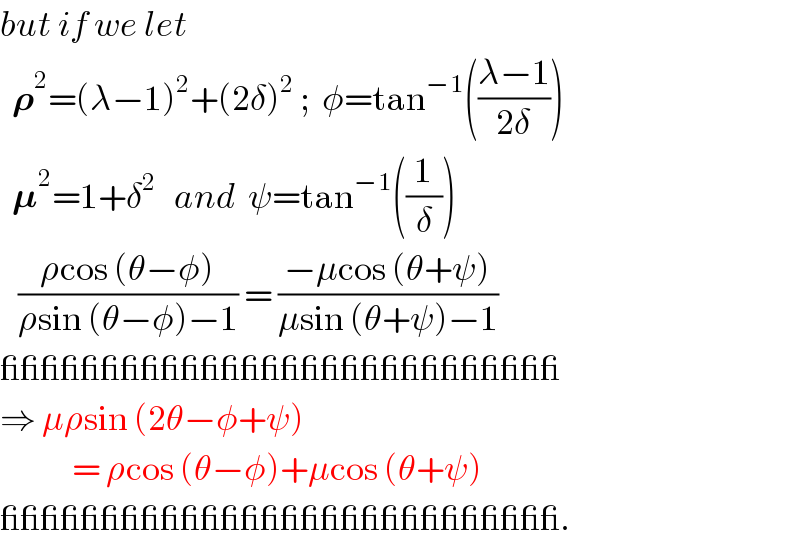
$${but}\:{if}\:{we}\:{let} \\ $$$$\:\:\boldsymbol{\rho}^{\mathrm{2}} =\left(\lambda−\mathrm{1}\right)^{\mathrm{2}} +\left(\mathrm{2}\delta\right)^{\mathrm{2}} \:;\:\:\phi=\mathrm{tan}^{−\mathrm{1}} \left(\frac{\lambda−\mathrm{1}}{\mathrm{2}\delta}\right) \\ $$$$\:\:\boldsymbol{\mu}^{\mathrm{2}} =\mathrm{1}+\delta^{\mathrm{2}} \:\:\:{and}\:\:\psi=\mathrm{tan}^{−\mathrm{1}} \left(\frac{\mathrm{1}}{\delta}\right) \\ $$$$\:\:\:\frac{\rho\mathrm{cos}\:\left(\theta−\phi\right)}{\rho\mathrm{sin}\:\left(\theta−\phi\right)−\mathrm{1}}\:=\:\frac{−\mu\mathrm{cos}\:\left(\theta+\psi\right)}{\mu\mathrm{sin}\:\left(\theta+\psi\right)−\mathrm{1}} \\ $$$$\_\_\_\_\_\_\_\_\_\_\_\_\_\_\_\_\_\_\_\_\_\_\_\_\_\_\_\_ \\ $$$$\Rightarrow\:\mu\rho\mathrm{sin}\:\left(\mathrm{2}\theta−\phi+\psi\right) \\ $$$$\:\:\:\:\:\:\:\:\:\:\:\:=\:\rho\mathrm{cos}\:\left(\theta−\phi\right)+\mu\mathrm{cos}\:\left(\theta+\psi\right)\: \\ $$$$\_\_\_\_\_\_\_\_\_\_\_\_\_\_\_\_\_\_\_\_\_\_\_\_\_\_\_\_. \\ $$
Commented by mr W last updated on 04/Feb/19

$${best}\:{form}\:{for}\:{result}! \\ $$
